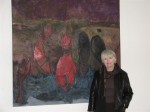Going fowl, foul… wait, it’s fair!
Judith Ann ponders kitsch and art and solves the Mystery of the Rocky Nest beneath Kilbourn Ave's flying metal flock.
In 1956, the Union Plastics Company of Massachusetts hired an art student by the name of Featherstone to revise their lawn flamingo, which was deemed flat and featureless. Featherstone flew high and eventually rose to VP of Union Plastics. Birds of pink plastic now plaster our landscape. Only slightly better than gnomes in pointy hats (Wisconsin’s favorite) or resin mushrooms or Virgins in cast-iron bathtubs, they define “what’s in our yards.”
What’s in our yards, both public and private, defines who we are.
Tis the season of green yards, and Beasties everywhere have reason to cheer — along with Snow White and Seven Dwarves frozen in concrete and a fido shaped from the same material. But none beats the tackiness of a Charles Manson yard sign designed by a local artist. To each his own, it’s your yard and your castle.
However, when it comes to public spaces (parks, boulevards, etc.), what we see is what we all get, like or lump it. The Gordon Park “Tip” sculpture, for example, took a few lumps from art and architecture critic Tom Bamberger when it was installed. Bamberger also decried the rusting heap in Catalano Square Park and called it “Brown Smudge.” If you want to know where bad stuff is, ask Bamberger.
And now to Birds of Knowledge of Good and Evil, a set of six aluminum sculptures sited on Kilbourn Avenue Boulevard, directly north of the Woman’s Club of Wisconsin. The WCW paid the price for the 2001 work by Polish artist, Magdalena Abakanowicz, and well, a few voices immediately tagged it as “Birds on Sticks.” I imagined the artist’s original concept as sparse and clean and lovely, so I wondered who was responsible for the addition of limestone boulders and the brick walkway leading to the birds?
It turns out that Abakanowicz is responsible. The rocks aren’t exactly changes, but rather part of the famed artist’s original concept. I learned the full story when I got lucky and spotted activity at the site where the birds head west to our downtown. Three women from WCW were chatting nearby, including Diane Buck, former director of “Save Outdoor Sculpture,” a Smithsonian project. She thinks of herself as a community activist, volunteer art educator, and the force behind getting “The Dirty Dozen” restored. Last year, the WCW formed a sculpture committee (including Buck). It set to work researching the overall condition and status of the installation.
“We knew the artist’s original concept had yet to be realized,” she said. “After consulting with the city, we brought about the enhancements of limestone rocks (around the upper perimeter of the mound), new LED uplights and a brick circle seating area and a walkway connecting the sculpture with the city-installed brick walk to the east.”
WCW applied and received support from the Milwaukee Arts Board, the goal being to check the structural integrity of the Birds and the poles on which they perch. A $5,000 grant allowed them to hire a local company, Vanguard, to assure they are conserved via thorough cleaning and careful waxing. Buck thinks the project is fine because it completes the artist’s vision, but she wishes other public art projects would be completed with the artist’s vision front and center.
“Rarely do groups understand that maintenance of sculpture is like maintenance of their car,” she says. “It needs to be done regularly.”
If you’ve ever studied the birds up close and personal, you have noted that their tail-ends include a nice round hollow space, a perfect place for genuine birds to build genuine nests and settle in…and so they did. Vanguard and the WCW solved the invasion by installing discrete rounds of metal mesh, thus preventing the fowl that aren’t faux from intruding upon the fowl that are.
A year ago in May, 1,400 Bernie Brewer lawn ornaments were planted across Wisconsin and then stolen by fans who tried to sell them on e-bay. The publicity fueled by the thefts was almost as good as the original marketing idea. A few years back, a Beastie was stolen and set adrift on the Milwaukee River. Milwaukee has it all: Rusting cars planted in front yards, and a dreadful Letter Carriers’ Monument, an ill-conceived grouping of mail carriers, each of whom appears to have collided with the others before being hurled off in opposite directions. Now and then, lawn ornaments of the majestic kind share common spaces if not common concepts. Beverly Pepper’s towering abstract, Cleopatra’s Wedge, is cozily north of a statue of poet Robert Burns, and the two pinpoint a site in a snug park at Prospect and Ogden.
It’s a far cry from that to an aluminum “tooth” fronting a dentist’s office near 60th & Hawley.
Art
-
Winning Artists Works on Display
 May 30th, 2024 by Annie Raab
May 30th, 2024 by Annie Raab
-
5 Huge Rainbow Arcs Coming To Downtown
 Apr 29th, 2024 by Jeramey Jannene
Apr 29th, 2024 by Jeramey Jannene
-
Exhibit Tells Story of Vietnam War Resistors in the Military
 Mar 29th, 2024 by Bill Christofferson
Mar 29th, 2024 by Bill Christofferson
























